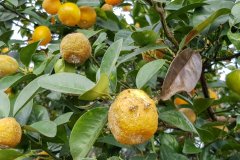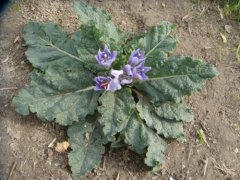Wendan pomelo pest narrow-breasted longicorn beetles harm, narrow-breasted longicorn beetles call spawning period control measures
According to the statistics of the Council of Agriculture, by 106, the planting area of Wendan pomelo in Taiwan was about 4272 hectares, and the producing areas were concentrated in Tainan City and Hualien County. In the past, narrow-breasted longicorn beetles, one of the pests of Wendan pomelo that only appeared in the western half of the country, were found for the first time in Hualien County the year before last. The agricultural improvement farm in Hualien District called on farmers to seize the opportunity to Eclosion adults in May and carry out field control when laying eggs to avoid affecting Wendan's quality.
The adults of narrow-breasted longicorn beetles emerge from the ground in May every year, mate and lay eggs in the cracks in the bark. After the eggs hatch, the larvae sneak into the soil and begin to eat the roots of the Wendan tree, resulting in a decline in the ability of plants to absorb nutrients and water and affect the growth of the plant. it may even cause germs to invade and cause compound damage, resulting in a decline in Wendan fruit yield.
Lin Li, an assistant researcher at Hualien Farm, said that in the past, narrow-breasted longicorn beetles were mostly found in the western half of the area. the year before last, some farmers in Hualien reported that narrow-breasted longicorn beetles had been found. last year, Hualien Farm promoted the prevention and control work, because narrow-breasted longicorn beetle larvae were born in the soil. It is more difficult to use pesticides to control them, so it is necessary to take advantage of the emergence of adults and spawning. Although it cannot be eradicated, it is hoped that it can be controlled under a certain density. Zheng Jung-Rui, director of the agricultural improvement farm in Tainan District, also said that narrow-breasted longicorn beetles are soil-dwelling pests, and it is difficult to control and eradicate them with insecticides. Therefore, physical control is often used at present, resulting in fewer and fewer offspring.
According to the past prevention and control experience of Tainan Field, including "light trapping adults", "newspaper or plank inducing spawning" and other methods can effectively control narrow-chested longicorn beetles.
In order to make use of the phototaxis of adults of narrow-chested longicorn beetles, the light traps and kills adults with white energy-saving light bulbs. Set up a shelter above the light bulb to prevent rain and leakage, place a basin below to fill up with water, and add detergents to prevent longicorn beetles from escaping; "newspaper, corrugated paper induces eggs" to make use of newspapers, corrugated folds are used as traps around the base of tree trunks, or spread on the border to concentrate eggs, collect eggs every week and destroy them. "Plank induced spawning" is to select a flat, crack-free board, leaning against the base of the trunk, using board overlap to create gaps to attract females to spawn. After decoration, you should inspect every week and remove the eggs until the end of the feathering period in June.
- Prev

How to control fruit flies and reduce the population of fruit flies? It is necessary to clean up the fruit drop and match the lure.
With the gradual increase of temperature, the population of fruit flies increases gradually, causing harm to fruit crops such as lotus fog, mango and so on. Huang Yubin, an associate researcher at the Agricultural Laboratory, said that fruit flies lay eggs in fruit crops such as guava, causing losses to fruit farmers.
- Next

Does Mandrake exist? what does it look like? Is it safe to grow Mandela in the garden
Mandrake officinarum, also known as Apple Satan, is making a comeback thanks in part to Harry Potter books and movies. Mandrake plants bloom in spring, with lovely blue and white flowers, in summer
Related
- A course of planting techniques and methods on how to grow carrots
- How to plant the latest tulips?
- Is it better to pick tea in the morning or in the afternoon? When is the best time for tea to be picked? what is the third or fifth tea?
- Launch Yuanxiao Happy combination Haocha + Tea Yuan healthy Taste
- Penghu Tourism "Fireworks 20 Parade with You"
- 2022 West Lake Happiness holds "Digital Revitalization Voucher" and draws iphone13 and laptop.
- Banqiao Fuzhou social houses are designed to change start-up combined with police elimination to create a safe and livable environment
- The convenient measure of "mechanical weeding" in Xinbei has been abused and the Agriculture Bureau has imposed heavy penalties on the illegal land consolidation.
- Changgeng University Joins Hands with Four Memory Factories to Rescue Memory Talent Shortage
- The list of Taiwan's top 100 MVP managers is listed by the Director-General of the Farmers' Association of Sanxia District.

